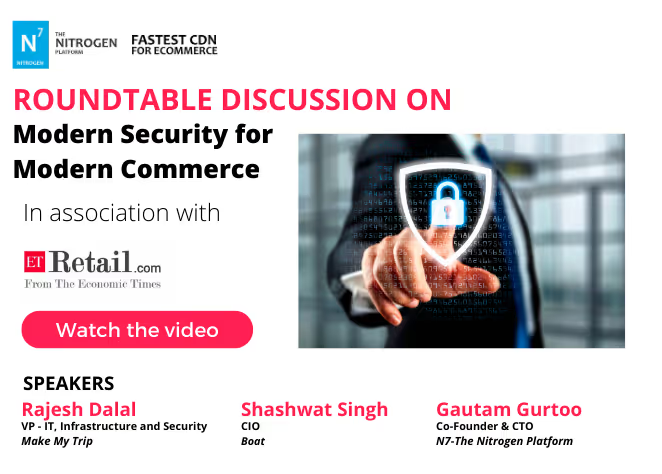How to Maximise Conversions for Ecommerce Websites During the Festive Season
.png)
The festive season is an exhilarating time for D2C and ecommerce brands, but it’s also fiercely competitive. According to industry trends, online sales during festivals have increased every year with recent data revealing a 25% spike in the first week of Diwali sales in 2024. This growth underscores the significance of meticulous planning and execution to thrive in a market where both brands and customers are more active than ever. We hosted a podcast on Maximising Conversions for Ecommerce Websites During Festive Season on October 25th and the session is graced by Amit Phutane, Chief Business Officer – Neeman’s along with Aniket Sharma, Director – Asia Business at Nitrogen.
Here's how your brand can stand out this festive season with practical strategies and expert insights.
1. Set Clear Objectives
Every brand must define its growth objectives for the festive season clearly. Whether it’s 2x, 3x, or 5x growth, the goal dictates the entire strategy," shares Amit, Chief Business Officer at Neeman’s, who brings over 25 years of D2C experience. According to him, "Focus on goals that align with your customer base and market dynamics. For some, it might be about increasing average order value, while for others, it's about maximizing repeat purchases."
Once your targets are defined, break them down:
- Product Contribution: Identify which products will drive the most sales.
- Channel Planning: Allocate expected revenue shares across your website, marketplaces, and other channels.
- Customer Segmentation: Tailor strategies for new users, existing customers, and loyal buyers.
Align your promotional calendar, inventory, and tech infrastructure to these goals. For instance, if electronics dominate festive sales with 75% of the market share, ensure stock availability and targeted marketing for trending gadgets.
.jpeg)
2. Prioritize Website Speed and Performance
During the festive rush, delays of even a few seconds can lead to significant dropoffs. Here’s how to optimize:
- Conduct a Speed Audit: Regularly monitor metrics like First Contentful Paint (FCP) and Largest Contentful Paint (LCP).
- Use Compression Tools: Optimize images and content for faster loading across all devices, including older models.
- Prepare for Traffic Spikes: Use content delivery networks (CDNs) and load balancers to handle sudden surges.
Amazon’s and Flipkart’s rapid load speeds, despite hosting millions of products, are benchmarks to aspire to. As Amit recounts, "We reduced a website’s load time from 18 seconds to 3.8 seconds, and the impact on conversions and bounce rates was astounding."
“Site speed isn’t just a technical detail; it’s a revenue driver. Reducing load times by just one second can improve conversions by 57%," emphasizes Amit.
3. Ensure Personalization at Scale
Personalization can be a gamechanger. According to Amit, "When a customer feels understood, their decision-making process accelerates. Dynamic personalization, driven by real-time analytics, can set your brand apart. Customers expect their preferences to be anticipated."
Tailored content, product recommendations, and offers based on:
- Browsing Behaviour: Use AI tools to track user preferences in real time.
- Past Purchases: Offer complementary products or exclusive discounts for repeat buyers.
- Demographic Insights: Create campaigns targeting specific age groups, geographies, or interests.
For example, a shoe brand could streamline the customer journey by asking a few quick questions: preferred activity (walking or running), size, and colour. Showing only relevant products simplifies decision-making, increases engagement, and boosts sales.
.jpeg)
4. Prepare for Tech Readiness
Festive seasons are prime targets for cyber threats and server crashes. Peak seasons demand peak preparedness, from both security and scalability perspectives.
Our speakers added, "Don’t overlook mobile readiness. Many customers will shop using mid-range devices, and your tech stack must cater to all."
Key steps include:
- Security Checks: Conduct Vulnerability Assessment and Penetration Testing (VAPT) at least two months prior.
- Mobile Optimization: With 75 to 80% of purchases happening on mobile, ensure your site is optimized for various screen sizes and operating systems.
- Checkout Testing: Ensure smooth add-to-cart, payment gateway, and checkout experiences.
5. Enhance Search Engine Optimization (SEO)
Your offers and new products should appear in search results as soon as they’re live. However, heavy JavaScript based websites can hinder SEO. Amit explains, "Java driven pages may look great but aren’t crawl friendly. Use tools to mirror them into HTML for better search visibility."
Additionally:
- Use search engine accelerators to speed up indexing.
- Include festive keywords in metadata, headers, and ad copies well in advance.
- Ensure your sitemap is updated and submitted to search engines regularly.
.jpeg)
6. Leverage Data Analytics for Smarter Decisions
Understanding past performance is critical to predicting and preparing for future trends.
Analyze the following:
- Historical Sales Data: Identify bestselling products and peak purchase times.
- Customer Behaviour: Track cart abandonment rates, popular landing pages, and user feedback.
- Competitor Pricing: Monitor discounts and offers to ensure your pricing remains competitive.
Aniket points out, "Data analytics isn’t just about looking back—it’s about looking forward. Use predictive analytics to forecast inventory needs and plan marketing budgets."
7. Build Seamless Navigation and User Journeys
Steve Jobs’ principle of simplicity resonates here. "In three clicks, a user should reach their desired product," Amit reiterates. To achieve this:
- Simplify navigation with intuitive filters (e.g., size, color, category).
- Implement AI based chatbots for personalized recommendations.
- Optimize your website for fewer steps to checkout.
- Create micro moments that surprise and engage shoppers at each step.
.jpeg)
8. Embrace Democratized Speed
Amit’s philosophy is clear: "Whether a customer uses a top tier phone in a metro city or a basic device in a smaller town, their experience should be seamless." Aniket echoes this sentiment, highlighting the importance of inclusive technology: "Equal access isn’t just ethical—it’s good business. Customers who feel catered to, regardless of their device, are more likely to return."
Use adaptive tools to:
- Normalize loading speeds across devices.
- Compress images and content dynamically.
- Optimize for 4G and slower internet connections.
Success Stories: Real-World Wins from Our Speakers
Amit shares, "We once improved a website’s speed from 18 seconds to 3.8 seconds. The results? Higher conversions, reduced bounce rates, and increased cart retention." Another success involved integrating HTML mirroring tools for a JavaScript heavy site, leading to better search rankings and traffic.
Aniket recalls, "One of our clients used real-time analytics to offer hyper localized discounts during the festive season. The result was a 40% increase in regional sales."
Conclusion: Win the Festive Season
The festive season is a make-or-break opportunity for ecommerce brands. By combining clear objectives, technical preparedness, and customer-centric strategies, your brand can maximize its potential. As Amit aptly summarizes, "Success lies in planning, execution, and efficiency. Nail these, and the festive season could contribute three months’ worth of revenue in just 30 days." The key is adaptability. The market changes rapidly during the festive season, and those who can pivot based on real-time insights will thrive.
Want to transform your website's performance? Reach out to our team at n7sales@n7.io.
FAQs
Why is the festive season critical for ecommerce businesses?
It’s when intent meets urgency. Consumers are actively searching, shopping, and spending, making it the most profitable window to acquire customers, clear inventory, and maximize lifetime value.
What are the first steps to prepare an ecommerce site for the festive season?
Audit your site performance, optimize key user journeys (homepage --> product --> checkout), and stress-test your backend for traffic spikes. Start early, execution wins over last-minute campaigns.
How does website speed impact festive season conversions?
Speed is currency during high intent moments. A delay of just one second can drop conversions by up to 7%. When every click counts, load time can be the difference between cart and bounce.
What tools can help improve ecommerce site speed during high traffic?
At N7, we deploy a multi-layered performance stack to ensure your site stays fast and stable, even during peak festive surges. Our Digital Experience Accelerator (DXA) dynamically optimizes critical assets like images and JavaScript for faster load times. SERA (Search Engine Rank Accelerator) delivers pre-rendered HTML to crawlers and real users for lightning-fast first paint. And with RDX (Real User Monitoring), we track real-time performance across devices and geographies to catch bottlenecks before they cost you conversions. Together, these tools don’t just handle traffic, they convert it.
How can personalization improve ecommerce sales during festivals?
Personalization turns festive browsers into buyers. By tailoring product recommendations, offers, and messaging based on user behavior and preferences, you reduce decision fatigue and increase cart value. At N7, we take personalization a step further—not just in content, but in performance. Our unique approach analyzes each user’s device, network conditions, and browser in real time to personalize content delivery. This ensures every visitor, regardless of their tech stack, experiences a lightning-fast, seamless journey—because speed is personal, too.

.png)


.jpg)